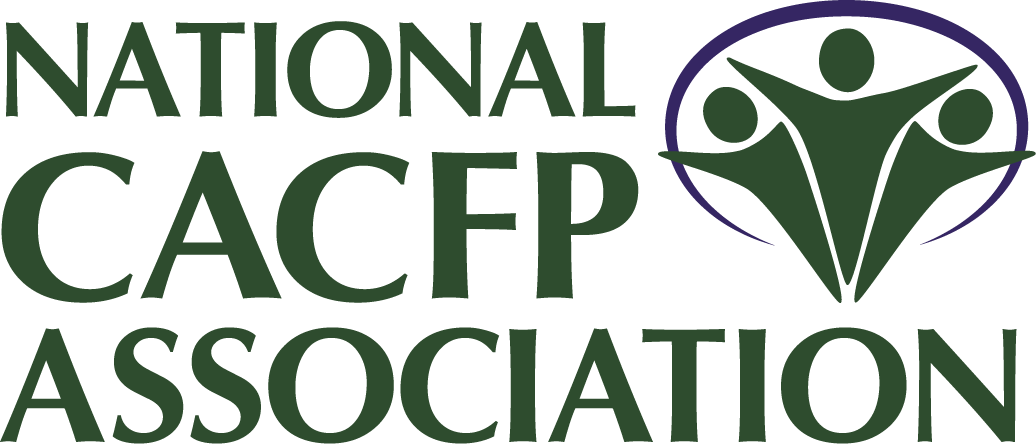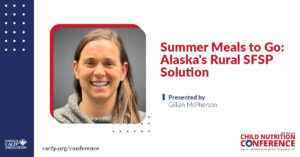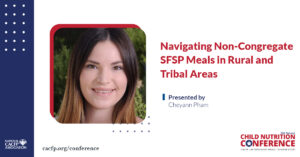2025 NCNC
Aligning Community CACFP & School Nutrition for Greater Impact
Explore opportunities to bridge connections between school districts and community-based organizations to support connecting families with participating programs year-round. Learn how to increase and leverage collaboration to create opportunities for alignment that support CACFP and SFSP and more effectively address food insecurity amongst the families you serve.
Read MoreSummer Meals To Go: Alaska’s Rural SFSP Solution
For some states, the SUN Meals To-Go program has just begun, and for others, the option is still to be explored. Get inspired to collaborate with others to serve rural summer meals in your state by hearing about the successes and challenges from the Meals To You Alaska demonstration project’s first year in operation.
Read MoreSummer Food: If I Knew Then What I Know Now
As a first-year sponsor of the SFSP serving congregate meals, there is much to learn, including the distinct differences between summer food and other federally funded food programs. Examine a new sponsor’s dive into the program, knowledge and strategies gained, and how you can make effective changes to maximize opportunities for both sponsor and sites.
Read MoreOperating a Non-Congregate Summer Food Service
Have you ever wondered what operating a non-congregate summer nutrition program looks like? How do you pick site locations? How do you navigate the complexity of developing a menu? How do you transport meal bags? How do families and children get to your location in rural areas? Discover helpful tips for all of these and successfully planning and operating your non-congregate feeding site.
Read MoreNon-Congregate Summer Feeding: 2024 Lessons for Summer 2025
Curious to see how Texas implemented non-congregate feeding in Summer 2024? Learn about the challenges faced in implementing a full non-congregate program in a short timeframe, the lessons learned, common issues and observations, and best practices for operators wishing to serve non-congregate SFSP meals in Summer 2025.
Read MoreNavigating Non-Congregate SFSP Meals in Rural and Tribal Areas
Are you curious about implementing SFSP Non-Congregate Meals (NCM) into your summer feeding options? Hear how an Arizona-based food bank discovered qualifying populations, operational implementation, and successes in reaching rural communities with an added perspective of administering the option to children in tribal communities.
Read MoreMaximizing SUN Programs Across Two State Agencies
USDA has created its exciting new SUN branding to unify Sun Bucks, Sun Meals-To-Go, and Sun Meals as a family of Summer Nutrition Programs for Kids! But what happens when these are administered by more than a single state agency? Overworked and short-staffed agencies can coordinate via partnerships to co-market and maximize program participation. Learn how the magic happens in North Carolina.
Read MoreLessons Learned: A Bright Future for SFSP Non-Congregate
How could one agency provide hundreds of thousands of meals during the summer of 2024 in several locations throughout two states? Parental pickup and home delivery services! Enhance your program and reach more children by understanding what worked (and what didn’t).
Read MoreInnovative Mapping Tools to Plan for Summer
The Texas Department of Agriculture (TDA) developed an interactive map to provide state and sponsor users with a common tool to easily determine which summer sites are eligible to offer non-congregate services. Learn how spatial analysis was used to streamline reviewing multiple eligibility criteria and how the map’s interface was designed to support intuitive user interaction.
Read MoreFunding Summer on a Shoestring and a Friend
Want to start a summer meal program but lack the budget? Learn how you can run a program with minimal resources and a few friends. Discover creative strategies to build a strong social network and community connections to provide meals for kids in need. Get the basics of managing a summer meal program, including tips on securing donations, partnering with businesses, and involving volunteers.
Read More









